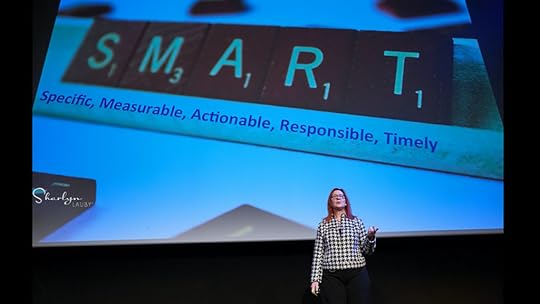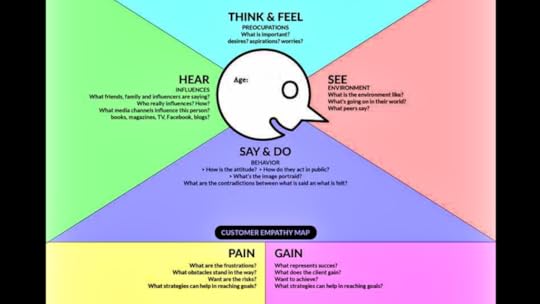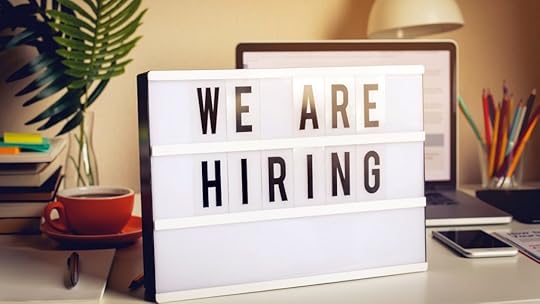Sharlyn J. Lauby's Blog, page 81
June 25, 2020
Get Employees Comfortable with Giving 360 Feedback – Ask #HR Bartender

As organizations start thinking about resuming normal (or new normal) operations, one aspect of the employee experience that will have to be addressed is the performance review. Every organization is going to do something different. For example, Facebook is eliminating the performance review for the first half of the year and giving every employee a $1000 bonus. But what about 360 feedback (aka multi-rater) reviews? That’s what this reader note is about.
Sharlyn, I’d love to hear your perspective on conducting employee reviews in the midst of the COVID-19 Pandemic? We conduct 360 feedback reviews and it feels insensitive at the moment to ask staff to evaluate their peers. (e.g. “I don’t like giving an honest (bad) review right now about a co-worker because it feels inappropriate, especially when humanity is supposed to be banding together”.)
I know that the review process should always be professional, but I’m concerned that people may feel odd about it in times of job uncertainty/stability and that it might not glean the most accurate and honest feedback. Would love your perspective. Thank you.
I totally get it. We keep using the word “unprecedented” when it comes to COVID-19 and it’s true. And we’re not completely past it yet. I also hate to say it, but as I was reading this note, I was able to think of other situations where employees might have the same hesitancy. For example, after a company files for bankruptcy, or has a senior executive die, or after a layoff, etc. So, I thought it might be helpful to talk about 360 feedback reviews in general and then discuss how to handle those “negative situations” including COVID-19.
To help us learn more about 360 feedback reviews, I reached out to Gabriel Dominguez Martin, CEO and co-founder of Primalogik. They are a provider of performance management technology solutions including 360 feedback reviews and employee opinion surveys.
Gabriel, thanks for spending time with us. We know that the organization in this note uses 360 feedback reviews. However, one of the things that we don’t know is whether the organization provided training for reviewers. Why is 360 feedback reviewer training important and what are a couple of tips to keep in mind when it comes to reviewer training?

[Dominguez Martin] To get quality results, it’s important to properly train reviewers before launching 360 feedback reviews. Your employees need to understand the purpose of these reviews, the company’s process, and how the results will be analyzed. They also need to receive guidelines on how to properly provide and receive feedback.
Explaining the purpose of the 360 feedback review. A 360 feedback review differs from a performance appraisal and it’s important that reviewers understand the difference between them both. Performance appraisals are generally conducted between the employee and their manager and typically focuses on the employee’s achievements and end-results. And, more often than not, the appraisal has a direct impact on compensation (getting a raise or a promotion).
On the other end, the goal behind a 360 feedback review is to get a better sense of an employee’s skill set by evaluating things such as their communication, leadership and teamwork abilities. The feedback provided will serve to create a self-development plan that will help the employee grow professionally and personally.
Explaining the 360 feedback review process. Typically, a 360 feedback review involves a certain level of anonymity so reviewers will feel comfortable sharing both positive and constructive feedback. Whether your organization decided to conduct a completely transparent review (where everyone can identify the respondents), only the HR admin can view respondents or no one can, it’s important to share this information with the reviewers.
Even when someone receives proper training, I can see how an individual might be apprehensive about sharing honest but negative feedback. What are a couple of things that organizations can share with reviewers about delivering negative feedback?
[Dominguez Martin] It’s important to phrase negative feedback in a constructive way and stick to facts or events, not personal feelings. Train your employees to wear the ‘coaching hat’ and recognize the end goal is to help the other person improve. So, what type of feedback will help this person grow? Provide useful tips to help them do a better job in that area.
I’m curious about best practices when it comes to doing 360 feedback reviews for employees who might not be ready to hear performance feedback whether it’s good or bad. Granted, organizations can’t delay things indefinitely but, I can see situations like an employee who just returned to work after an accident or an employee who is juggling several intense projects not being the ideal time to conduct a 360 feedback review.
[Dominguez Martin] There are many factors that can impact an employee’s performance and behavior on a regular basis. Employees can experience anger, anxiety, and stress from their personal life or work environment. Sometimes as a manager you might be unaware of these things. A 360 feedback review will help you see if your employee is having difficulties, and this can help you start a conversation with them. You’ll be able to work together to create a better development plan and review their workload if necessary.

Given what’s currently happening in the world today (i.e. COVID-19), what are you hearing in terms of organizations conducting reviews right now? Are most organizations moving forward with the process or postponing it for later in the year or maybe something else?
[Dominguez Martin] It really depends on how COVID-19 impacted your business. If your business is doing okay, and people are not at risk of losing their job, you should continue conducting reviews. However, it’s important that you adapt the process to your new reality. We’ve seen most companies shift their activities and have their employees work from home. This of course can impact the work dynamics and you might want to adapt your questionnaire and process to reflect this new reality. Consider changing or adding questions in your 360 feedback review about new competencies that are more valued now than they were before. You should also be more proactive at getting and providing feedback to employees as most of them are getting less in-person interactions and feedback than before.
Don’t forget that a 360 feedback review is a tool used to create a self-development plan. So even if goals and expectations have shifted, this should not impact your 360 feedback review.
I want to thank Gabriel for sharing his time and knowledge with us. If you want to learn more about using 360 feedback tools, check out their blog.
Organizations have more to think about than simply extending remote work or bringing employees back to the office. Employees will still want to hear about their performance. It’s important to discuss how processes like performance reviews, development plans, and goal setting will be handled in this changing environment.
Image captured by Sharlyn Lauby while exploring the streets of Fort Lauderdale, FL
The post Get Employees Comfortable with Giving 360 Feedback – Ask #HR Bartender appeared first on hr bartender.






June 23, 2020
A Compliant Return to Work Plan: 7 Tips

(Editor’s Note: Today’s article is brought to you by our friends at Poster Guard , a division of ComplyRight and the leading labor law poster service that gets your business up to date with all required federal, state and local labor law postings, and then keeps it that way — for an entire year. Enjoy the read!)
Whether your organization is reopening the operation or returning to normal production levels post- COVID-19, the process isn’t as simple as unlocking the doors and calling employees back to the workplace. Legal requirements and best practices can vary greatly depending on your industry, location, and work environment.
We recently shared some information about the Families First Coronavirus Response Act (FFCRA). Since then, there’s been additional guidance for employers issued by the Center for Disease Control (CDC), the Equal Employment Opportunity Commission (EEOC), the Occupational Safety and Health Administration (OSHA), along with many states, counties, and cities governments.
To ensure the safety of employees and to protect against legal liability and stay compliant as you develop your return to work plans, here are seven tips to consider:
Know the rules for a compliant reopening in your area.
Organizations will want to check the most recent government orders, including federal, state, county and city requirements that apply to your specific industry. Wherever they are inconsistent, it could make good business sense to follow the strictest standards. And you’ll want to review government orders frequently, as they can change from day to day – and could even revert back to stricter requirements if a “second wave” does happen.
Consider forming an “opening team” and assign them responsibility for monitoring communications from all levels of government so there’s clear accountability. Use the RACI model to work out formal communication and decision-making procedures to ensure an organized and timely response to any new orders.
Create a “welcome back” plan.
For employees who are working effectively from home, consider letting them continue until there is more certainty that the spread has been effectively contained. Don’t forget that there are labor law posting requirements for remote workers that must be met to stay compliant. Over the past three months, there have been more than 45 mandatory labor law posting updates affecting U.S. employers, and these postings must be provided to all employees whether they work onsite or remotely.
Organizations with fewer than 500 employees will need to abide by the paid leave requirements of the Families First Coronavirus Response Act (FFCRA), as well as any state or local emergency leave laws. This means you may have employees that are entitled to continued leave (job-protected time off) if they are unable to return to work due to certain COVID-related reasons, including the closure of a child’s school, camp, or day care.
Before requiring employees to return to the workplace, also make sure to check state and/or local guidelines for your industry, as they may include specific restrictions addressing re-entry to the workplace, such as limitations on how many employees may work in an enclosed area, restrictions on certain work activities, and other requirements tied to phased re-opening guidelines. . Oh, and just a reminder that if the company is technically rehiring an employee, you typically have to provide all of the new hire mandatory forms, notifications, and handouts required for new employees to be compliant.
Establish health screening protocols.
It’s important to decide whether and how the organization will screen employees for illness. Will the company conduct daily symptom checks or other ongoing health screens? The EEOC is allowing employers to conduct temperature checks (even onsite) during the pandemic but it will be necessary to check your state and local orders to determine whether a mandatory posting and/or policy is required regarding temperature checks.
Remember, if the company does implement any type of health screening process, they will want to be sure to comply with applicable privacy and discrimination laws – such as the Americans with Disabilities Act (ADA) and the Health Insurance Portability and Accountability Act (HIPAA) – when collecting this type of information.
Post reminders about distancing and increased hygiene procedures.
Some state and local orders are requiring certain businesses to notify employees and visitors of certain cleaning, hygiene, and personal protective equipment (PPE) practices. This could include compliant signage about hand washing, social distancing, covering coughs and sneezes, temperature checks, and wearing masks or face coverings. For instance, Arkansas has a “Stop the Spread of COVID-19” posting requirement.
Organizations will want to examine their work areas and consider floor decals or markers to designate one-way traffic through hallways or aisles. It might also make sense to add signage to remind workers and visitors to maintain safe distancing and designate restricted areas.

The organization should also establish new protocols for frequent cleaning and disinfecting of all work areas, including restrooms, light switches, door handles, elevator buttons, and other high touch surfaces more than once a day. Consider adding no-touch trash receptacles in places like employee break areas. Ensure that ventilation systems operate properly and leave doors open wherever possible to reduce surface contamination.
And, be prepared to decontaminate the workplace thoroughly should an employee test positive with COVID-19 (see #6).
Revisit workplace policies and provide training.
HR departments will want to give the employee handbook a comprehensive review. New workplace realities may call for updates to existing policies, including attendance, work schedules, remote work, and sick leave. In some cases, compliant policy updates and employee communications are mandatory based on new employment laws prompted by the pandemic. For example, San Francisco, California has a COVID-19 Public Health Emergency Leave handout and the District of Columbia has a notification requirement for Family and Medical Leave During COVID-19.
In addition, seven states (Alaska, Michigan, Mississippi, Ohio, Pennsylvania, South Dakota, and Texas) have added COVID-19 handout and/or posting requirements related to paydays, separations, or unemployment insurance.
Communicating and training employees on any new safety policies and procedures (see #3 and #4) should be a top priority. Organizations should plan to deliver separate training to supervisors and managers on how to handle employee requests for leave, what to do if an employee exhibits symptoms while onsite, and expectations on how they should address and enforce any new policies.
Prepare a response plan for employees who exhibit symptoms or get diagnosed.
While we hope it never happens, every employer should anticipate that, at some point, an employee will be affected by COVID-19 after returning to the workplace. You’ll want to be prepared to take swift action.
If an employee fails a health screening or exhibits symptoms while working onsite, send them home. Contact local health agencies for additional guidance. Organizations will want to notify coworkers who may have been exposed by the affected employee and ask them to self-isolate for 14 days. When notifying other employees, do not share the name of the affected employee or answer questions that could reveal their identity. This is considered private medical information protected by the ADA and applicable HIPAA rules.
Same applies if an employee tests positive for the virus. Inform all employees immediately and directly notify any individual employees who have been in close contact with the diagnosed worker. (Again, be sure to protect the privacy of the affected employee.) Consider closing down the work area or facility temporarily for cleaning and disinfection.
Depending on the situation, it will be necessary for the organization to determine whether the illness could be considered work-related according to OSHA rules.
Stay agile and be ready for more change to keep compliant.
As employers move forward with their business plans in the midst of COVID-19, one thing is certain: more change will come. Every week, we learn new facts about the virus and new guidelines are being issued to mitigate its risk.
Organizations will want to regularly monitor guidance from government agencies and health officials. This is a rapidly evolving area of legislation, so it’s important to be connected with knowledgeable legal advisors to ensure compliance with the latest regulations. Odds are, every employer will need to revise their safety policies and procedures more than once over the coming months.
That’s one reason why it makes sense to partner with a labor law posting service like Poster Guard. I’ve mentioned before how I much I believe in this type of service because it frees up HR to focus on the business. And it’s even more important now. HR departments want and need to be focused on helping the organization meet its goals and targets. They want to help welcome employees back to work and they want everyone to be safe. They’re not looking to spend their time researching what COVID-19 posters and handouts are required in their state and city.
Poster Guard understands this too. That’s why they’re offering $30 off to their Poster Guard Compliance Protection product. This annual service covers federal, state, city and county labor law postings, and is available in electronic formats for your remote workers, too. And when the law changes, you automatically receive the new postings as part of the service. Poster Guard also offers an expanded service that covers all of the federal, state and local mandatory employee handout requirements, including the COVID-19 requirements mentioned in this article.
It seems to me that organizations right now are looking for ways to work safe, smart and compliant. Think about how HR departments should be spending their time right now and where they bring the most value. Organizations want their HR teams to help them hire, engage, and retain talent. Leave researching labor law handout and posting requirements to the professionals.
The post A Compliant Return to Work Plan: 7 Tips appeared first on hr bartender.






June 21, 2020
Managers: You Can Give Bad News to Employees with Respect

During this time, organizations are in different places when it comes to their employees and employment. By this I mean some companies are hiring, where others are cutting hours, and/or considering furloughs and layoffs. In fact, it could also be possible that one department or division of the organization is cutting back while another has a lot of work and not enough employees.
Unfortunately, regardless of where your organization is during this time, it doesn’t make you immune to having to deliver bad news. This could be a real struggle for organizations and managers that have never really had to deliver bad news before. Or they haven’t had to deliver bad news in quite some time.
But it is possible to deliver bad/sad news in a way that’s respectful to employees. This is an area where human resources departments can help. We can listen and coach managers through the process of crafting and delivering tough messages. The way to do it is by keeping the basic tenets of the employee experience in mind.
Be honest and transparent. Obviously, employees want answers about their job and security. But frankly, sometimes organizations don’t know whether they’re going to have to cut hours, do layoffs, or furlough employees. It might be tempting to sugarcoat an answer. Employees need to hear the truth. If you don’t know the answer, don’t make one up. And if you need some guidance, call your legal counsel for assistance about what you can and shouldn’t say.
Be respectful. Managers know that delivering bad news is hard. Human nature sometimes tells us to deliver the message quickly because it doesn’t drag out the negativity and it makes us feel better. Let me deliver some tough love here: this isn’t about us feeling better. Managers should communicate messages to employees in a way that makes the employee feel good about their contributions to the company. In the case of this pandemic, the company and the employee did not create the situation. But they still need to deal with it. Let the employee know that their work was appreciated and valued.
Be helpful. This is another area where HR can get involved. If the organization has resources, use them to help employees. I’ve seen companies organize job fairs, offer outplacement assistance, and bring in resume writers to conduct workshops. Organizations have also extended certain employee benefits to help with the transition such as use of a company-issued cellphone. If your company has limited resources, see if there are community-based organizations, like your local workforce development board, that can offer assistance.
Be there for employees. We’ve already heard the horror stories of layoffs happening en masse via email or Zoom. That’s definitely not in the best practices playbook. I’m not advocating the approach, but organizations are also dealing with physical distance guidelines that we need to observe. This is another time to loop in your legal counsel to figure out the best way to deliver unpleasant news at the organizational and individual level. HR and management will want to work together to make sure employees hear the message from the right person. There’s nothing worse than hearing your job is being eliminated from a coworker. Trust me on this one.
Be empathetic. The phrase “We’re in this together.” has been said a lot. And it’s true. What we’re experiencing now is impacting every level of the organization. Every job. Every person is being impacted by what’s happening. I hate to say it but it’s possible that the manager who is telling employees that their job is being eliminated today will have their job cut soon. We all understand the frustration of things not being “normal” and it’s okay to be empathetic. In fact, letting employees know that you understand is one of the most human things you can do.
Through these tough times, organizations need to remember the value of their brand. Companies didn’t spend huge amounts of time and resources to build a great place to work only to have it disappear through poor messaging. Yes, the bottom-line is important but people are more important. Because companies will need employees to help them bounce back from this. And having a negative reputation won’t help. Will employees be thrilled if they hear bad news? No, of course not.
Will they respect that the company treated them with respect? Yes. Yes, they will.
Image captured by Sharlyn Lauby while attending the WorkHuman Conference in Austin, TX
The post Managers: You Can Give Bad News to Employees with Respect appeared first on hr bartender.






Managers: You Can Give Bad News to Employees with Repect

During this time, organizations are in different places when it comes to their employees and employment. By this I mean some companies are hiring, where others are cutting hours, and/or considering furloughs and layoffs. In fact, it could also be possible that one department or division of the organization is cutting back while another has a lot of work and not enough employees.
Unfortunately, regardless of where your organization is during this time, it doesn’t make you immune to having to deliver bad news. This could be a real struggle for organizations and managers that have never really had to deliver bad news before. Or they haven’t had to deliver bad news in quite some time.
But it is possible to deliver bad/sad news in a way that’s respectful to employees. This is an area where human resources departments can help. We can listen and coach managers through the process of crafting and delivering tough messages. The way to do it is by keeping the basic tenets of the employee experience in mind.
Be honest and transparent. Obviously, employees want answers about their job and security. But frankly, sometimes organizations don’t know whether they’re going to have to cut hours, do layoffs, or furlough employees. It might be tempting to sugarcoat an answer. Employees need to hear the truth. If you don’t know the answer, don’t make one up. And if you need some guidance, call your legal counsel for assistance about what you can and shouldn’t say.
Be respectful. Managers know that delivering bad news is hard. Human nature sometimes tells us to deliver the message quickly because it doesn’t drag out the negativity and it makes us feel better. Let me deliver some tough love here: this isn’t about us feeling better. Managers should communicate messages to employees in a way that makes the employee feel good about their contributions to the company. In the case of this pandemic, the company and the employee did not create the situation. But they still need to deal with it. Let the employee know that their work was appreciated and valued.
Be helpful. This is another area where HR can get involved. If the organization has resources, use them to help employees. I’ve seen companies organize job fairs, offer outplacement assistance, and bring in resume writers to conduct workshops. Organizations have also extended certain employee benefits to help with the transition such as use of a company-issued cellphone. If your company has limited resources, see if there are community-based organizations, like your local workforce development board, that can offer assistance.
Be there for employees. We’ve already heard the horror stories of layoffs happening en masse via email or Zoom. That’s definitely not in the best practices playbook. I’m not advocating the approach, but organizations are also dealing with physical distance guidelines that we need to observe. This is another time to loop in your legal counsel to figure out the best way to deliver unpleasant news at the organizational and individual level. HR and management will want to work together to make sure employees hear the message from the right person. There’s nothing worse than hearing your job is being eliminated from a coworker. Trust me on this one.
Be empathetic. The phrase “We’re in this together.” has been said a lot. And it’s true. What we’re experiencing now is impacting every level of the organization. Every job. Every person is being impacted by what’s happening. I hate to say it but it’s possible that the manager who is telling employees that their job is being eliminated today will have their job cut soon. We all understand the frustration of things not being “normal” and it’s okay to be empathetic. In fact, letting employees know that you understand is one of the most human things you can do.
Through these tough times, organizations need to remember the value of their brand. Companies didn’t spend huge amounts of time and resources to build a great place to work only to have it disappear through poor messaging. Yes, the bottom-line is important but people are more important. Because companies will need employees to help them bounce back from this. And having a negative reputation won’t help. Will employees be thrilled if they hear bad news? No, of course not.
Will they respect that the company treated them with respect? Yes. Yes, they will.
Image captured by Sharlyn Lauby while attending the WorkHuman Conference in Austin, TX
The post Managers: You Can Give Bad News to Employees with Repect appeared first on hr bartender.






June 18, 2020
Use SMART Plans to Create Actionable Goals

When I attend conferences, one of the things that frustrates me is when the speakers present a topic and, in the final couple of minutes of the session, they say something to the effect of “…and I challenge each of you to leave this session and create your own personal action plan to…” do whatever is that they’re suggesting we do. Frankly, they should also include in their presentation how to create the action plan.
As a result, and to minimize my frustrations, I’ve learned that every time a speaker issues one of these challenges that I should try to work it into a SMART plan. I’ve mentioned before how much I love SMART plans and find it to be a very flexible way to set goals and hold myself accountable.
I will admit that I haven’t always felt this way about SMART plans. I once worked for a company that every time something went wrong, our CEO wanted a SMART plan explaining how we were going to fix it. Sad to say, we developed a lot of SMART plans. Back then, I thought it was some sort of punishment. It wasn’t until I started studying for my professional certification that I realized SMART plans have been around for many years and weren’t some dreamt up form of torture from senior management.
If you’re not familiar, SMART is an acronym:
Specific is a statement of exactly what you would like to accomplish. Think of it as the who, what, where, when, which and why of the goal.
Measurable answers the question of success will be measured.
Achievable outlines the steps that it will take to complete the goal. Some people call this step “attainable”.
Responsible assigns accountability to each step of the process. Instead of responsible, some people label this step as “relevant” or “realistic” to answer the question of goal importance (i.e. relevant and/or realistic).
Time-bound (some versions use “trackable”) identifies the time frame to achieve the goal.
Over the years, I’ve found the SMART acronym easy to remember so I mold it for setting my personal goals and even use it for creating meeting minutes. I can’t think of a better way to document meeting discussions:
Specifically, what are we going to do? (Specific)
How will we measure our success? (Measurable)
What are the steps that will help us attain our goal? (Attainable)
Who will be responsible for each step? (Responsible)
When will the task be completed? (Time-bound)
Using the SMART plan for meeting minutes also helps me steer the conversation toward key discussions like “We have a great idea here…now who’s going to take ownership for getting it done?” And “Thanks Jose for leading this task, when can we expect it to be completed?”
So, the next time someone challenges you to develop an action plan, think about giving SMART plans a try. Anyone using another method to create personal action plans? Share what works for you in the comments.
Image of Sharlyn Lauby speaking at the Flora Icelandic HR Management Conference in Reykjavik, Iceland
The post Use SMART Plans to Create Actionable Goals appeared first on hr bartender.






June 16, 2020
Employee Experience: Using Empathy Maps to Design Better Engagement

Earlier in the year, Mr. Bartender and I attended one of our favorite events, WordCamp Miami. Since HR Bartender runs on a WordPress platform, we try to attend at least one WordCamp conference each year to keep up on the latest.
While I am by no means a developer, one of the sessions that I attended in the developer track really hit home for me. It was a session about the user experience and how developers need to have empathy for users when designing websites. The speaker said, “You are designing for other people. Who are these people? What do they think and feel?”
I immediately thought of the employee experience. Organizations are designing the employee experience and should be asking themselves, “You’re designing for employees. Who are our employees? What do they think and feel?” One way we can get to the answers of these questions is by creating an empathy map.
An empathy map is a template that helps identify what customers think/feel, hear, see, and do. Developers also use them during the design process. I must admit that I hadn’t heard of empathy maps until WordCamp, but I could see them being a useful tool for HR and management to develop personas.
Companies already develop customer personas as part of their marketing plans. And HR departments create candidate personas as part of their talent acquisition strategy. Why not create an employee persona to help with the development of the employee experience? Now, before we go any further, let me clarify that personas are not intended to be tools for discrimination and exclusion. Personas are designed to creating understanding and focus.
The idea behind using an empathy map for the employee experience is to gather data about employees and then analyze it. Organizations can collect data via face-to-face interviews, focus groups, and surveys. The information would help the organization understand employee motivations, frustrations, and goals. Because the intent of the employee experience is to increase motivation, reduce frustrations, so employees are able to accomplish their goals.
Once we have a better understanding of who our employees are (by creating personas from the empathy maps), the organization can create a plan to build or redesign the employee experience. If the company already has an employee experience strategy, then it’s possible this activity will confirm your actions. Or maybe indicate that a couple of things need tweaking. While the speaker in this WordCamp session recommended using a journey map to create the plan, I can see how a SMART plan could do the same thing. And since I’m a big fan of SMART, I would probably go that route. Bottom-line: use an action planning tool that you know yields results. Execution is key.
Finally, the speaker talked about creating stories to connect employees to the plan. I’ve been hearing more about using storytelling in the employee experience these days. My take is that this is a great way to market that the organization is listening and taking action. The speaker used a simple 3-step sentence to create stories: WHO – WHAT – WHY. Have employees fill in the blanks: As a WHO, I want to WHAT, so I get this WHY. An employee response might look like, “As a manager, I want my employees to succeed, so I can help the company achieve its goals.”
I expect that over the summer, more businesses are going to start a phased plan for bringing employees back into the office. It’s possible that the workplace will be different. Now might be a perfect time to revisit the organization’s employee experience strategy to ensure that employee needs are still being met.
Empathy Map courtesy of Orange Snowman
The post Employee Experience: Using Empathy Maps to Design Better Engagement appeared first on hr bartender.






June 14, 2020
Career Development: 5 Activities You Can Do Today

Right now, many of us are concerned about our career. Maybe you’ve been furloughed or laid off. Maybe you’re still working but are starting to hear rumors. Or maybe you’ve been thinking about making a career change for several months. Regardless of your situation, you should be thinking about your career and how to position yourself for opportunities.
There’s a saying in recruiting, “Always be closing.” Well in career development it’s “Always be ready.” As in, “Always be ready for your next opportunity.”
At last year’s HR Technology Conference, I attended a session led by Cornerstone OnDemand which was focused on the topic of career development. They outlined five activities that we should be doing to elevate our careers. The activities were relevant then and they’re still relevant today. What I like about this list is that we can apply it in both a group learning environment as well as a self-learning one.
Befriend machines. With many of us working from home are becoming more connected to technology. That’s not a bad thing. While technology isn’t going to replace human interaction, gaining digital fluency skills is important. This is an opportunity to demonstrate that we can work effectively on our own as well as in a collaborative environment using technology.
Build your tribe. It is possible to cultivate positive business relationships while working remotely. Look for opportunities to virtually network inside and outside the organization. Share valuable information via social media. Respond to calls and emails in a timely fashion. Be willing to listen when a friend or colleague needs you – maybe for their career development.
Make yourself known. We’re not talking about being pushy here. Think of making yourself known as in the famous quote from Steve Martin, “Be so good they can’t ignore you.” Spend time reflecting on your personal brand and reputation. Are there aspects of your brand that you’d like to change? Also consider spending some time to increase your knowledge of other cultures.
Make sense. Cornerstone explained this one as being focused on getting better with logic. I could see that as improving critical thinking and business acumen. Look for opportunities to connect qualitative information and quantitative data to tell a business story. This could also be a great time to demonstrate the ability to successfully manage change.
Keep it going. Whether we’re working from home or in an office environment, we need to show that we practice ethical behavior in our personal and professional lives. We should demonstrate empathy and emotional intelligence in our interactions with others . And it can be far more difficult than it sounds, but we should find ways to celebrate our resilience to the ever-changing world around us.
As you look at your career – in terms of what you would like to be doing in the future – think about what you need to learn and how you would like to learn it. I know group learning sessions can be a lot of fun, but there are some things that would be better to learn via self-learning. Now might be the right time to focus on those self-directed activities. It could really take you places!
The post Career Development: 5 Activities You Can Do Today appeared first on hr bartender.






June 11, 2020
Servant Leadership: Excellent Leaders are Good Followers

I ran across an old quote from Herb Kelleher, former CEO of Southwest Airlines the other day which said, “To be an excellent leader, you have to be a superb follower.” It reminded me of a program that I participated in years ago called Leadership Broward. The program was designed to encourage business leaders to become active community stewards. One of the concepts shared during the program was servant leadership. I found it fascinating and Kelleher’s quote is really the essence of servant leadership.
If you’re not familiar with the concept of servant leadership, here’s a little history. Servant leadership was started in the 1970’s by Robert Greenleaf, director of management research at AT&T. Greenleaf’s job was to study how the best leaders emerged in organizations. During the same time, Greenleaf was personally troubled by the student unrest on college and university campuses.
So, Greenleaf decided the best way to understand the youth movement was to read a novel that was very popular with youth at the time. The novel was “Journey to the East” by Hermann Hesse. SPOILER ALERT: “Journey to the East” is about a group of people traveling to a new land. Accompanying the group is their servant, Leo, who sings songs of encouragement and takes care of their stuff. During the trip, Leo disappears. The group struggles to stay together and eventually disbands. Several years later, it’s discovered that Leo – the group’s servant – was really their leader.
Inspired by Leo’s character, Greenleaf realizes the key to leadership lies in “serving” (aka focusing on the people you manage) and writes what’s considered to be his most famous essay, “The Servant as Leader”, which outlines ten basic competencies associated with servant leadership. I’ve highlighted a few of them below.
Commitment to developing people. Excellent leaders help others become good leaders. You’ve heard me say before that a manager’s job is to hire and train their replacement. This directly ties to that. Good leaders aren’t threatened by others and make time to help the people in their team grow.
Empathy. Empathy is easy to say but in practice, is really hard. Leaders not only identify with others but accept them for who they are. Great leaders seek to understand differences.
Listening. Other leadership experts have written about the importance of listening. A leader responds to a problem by listening first. We have to move past the stereotype that leaders have all the answers. The reality is that leaders need to be open to admitting that they don’t.
Conceptualization. Leaders articulate a clear vision with passion, which engages and energizes the rest of the team. While I’m not sure that we always have a clear vision of the future, I do believe we can do a good job of communicating our passion and intent.
Foresight. This ties into #4. Greenleaf says that leaders can sense the future. It’s what gives leaders their “lead.” I like to think of this as leaders must use good decision-making skills. And we should remember that a lack of decision making can be perceived as an ethical failure.
Awareness. Self-awareness of our strengths and weaknesses is necessary. Leaders must open the doors of perception and see what’s inside. This can be scary, but it’s necessary to provide reality and see things in proper perspective.
I’ll admit that Greenleaf’s writings have taken some hits over time. But in reading his words on servant leadership, I find it amazing that over thirty years later, many (if not all) of the characteristics are still associated with leadership. These competencies may not be called by the same name, but the traits are similar. It’s a reminder that’s there is no silver bullet to being a good leader. But if there was, maybe first serving the people around you is it.
Image captured by Sharlyn Lauby while exploring the streets of Las Vegas, NV
The post Servant Leadership: Excellent Leaders are Good Followers appeared first on hr bartender.






June 9, 2020
Recruiting In the Era of Social Distancing

(Editor’s Note: Today’s article is brought to you by our friends at Criteria Corp, a leading provider of pre-employment testing services. If you want to learn more about how pre-employment testing can benefit your talent acquisition strategy, check out Criteria Corp’s “Definitive Guide to Pre-Employment Testing”. I’ve found it to be a comprehensive guide that I keep on the corner of my desk all the time. Enjoy!)
As organizations plan for reopening or ramping up their operations, they need to have a plan. And that plan should be in compliance with the Center for Disease Control (CDC) guidelines. But even as we’re dealing with fewer restrictions, that doesn’t change the fact that COVID-19 is still something we need to deal with.
I’m sure you’re talking with people and seeing the same comments that I am about whether or not it’s safe to go out or do certain activities. Customers are making decisions about their comfort level in visiting businesses. For example, should we dine inside a restaurant or get takeout. Employees will be making the same decisions about their comfort level with the organization. For instance, “Is this an employer that will make my safety and wellbeing a priority?”
Organizations Should Review Their Recruiting Processes
That’s why companies need to look at not only their customer processes but their employee processes. It starts with recruiting. Part of the organization’s reopening plan should be to be examining the current hiring process and look for areas that they might need to address.
We’re not just talking about the interview. How will all of the steps in the recruiting and hiring process be handled – from background checks to drug screens to orientation in the era of distancing? Here are a few things that smart companies are discussing:
Consider video screening and interviews. Obviously, this is becoming a very popular option right now. And there are some free providers, which is extra nice. But organizations will want to select the right technology for their needs and make sure data privacy isn’t an issue with the platform. In addition, it will be important to have a plan in place for candidates who do not have the technology capability to do a video interview.
Make decisions about logistics for in-person interviews. Video interviews will not be right for every organization and that’s fine. When it comes to the in-person interview, organizations will want to decide how they will handle masks (when they will be worn and removed), where interviews will be held (and how they will be cleaned between interviews), as well as the best way to respond to social greeting (like declining to shake hands).
Provide candidates with interview guidelines. Regardless of whether you’re recruiting with in-person or video interviews, organizations should provide candidates with information in advance about how the interview will be conducted. You don’t have to give out the questions in advance but do explain logistics. And if you’re doing video interviews, offer some tips for using the technology including what to do if it doesn’t work.
Remind managers that they still need to prepare. This is a new process that will impact everyone. Managers need to get comfortable with it as well. That might mean testing out a new technology. If they’re doing interviews from home, suggest that they wear their normal office attire (versus working from home attire). That might help set the right tone. And managers should be ready to discuss with candidates any changes to the job description because of COVID-19 such as temporarily allowing working from home, possible shift changes, etc.
Start the interview with some ground rules. Put the candidate at ease by explaining what will happen. If you’re conducting a video interview, let the candidate know that it’s okay if you hear dogs barking, kids laughing, and the garbage truck. It’s possible that the recruiter or hiring manager might have to apologize for their own background noises and interruptions. It’s just part of the new normal for recruiting.
Use assessments strategically. Due to adjustments in the hiring process, it’s possible that the organization might want to focus on skills like agility and trainability. I can see those qualities as being very important right now. Organizations might consider using a cognitive ability assessment and positioning it earlier in the process. The key is to align any assessment with the job and make sure it’s valid for recruitment and selection.
Wrap-up the interview by providing clear details. Tell candidates how to stay in touch. If the recruiter and hiring manager are working remotely, the best way to communicate might be different from when everyone was working in an office environment. It could also make some sense to let the candidate know that the final decision might take longer given the circumstances.

Include Safety and Distancing in the Candidate Experience
It is possible to give candidates a positive hiring experience even while distancing. In fact, candidates will appreciate knowing that the organization they’re interviewing with places a priority on employee safety and security in their recruiting. The key is planning a safe process and then communicating it to everyone involved.
If you want to learn more about talent management strategies to consider during this period of reopening and returning to the workplace, join me and the Criteria Corp team for a webinar on Wednesday, June 24 at 10a Pacific / 1p Eastern. We’ll be talking about “Talent Management While Distancing: 7 Things to Consider”. Hope to see you then!
The post Recruiting In the Era of Social Distancing appeared first on hr bartender.






June 7, 2020
Changing Employee Compensation – Ask #HR Bartender

There are days when I’m totally amazed at some of the things that I hear employers are doing. While this reader note is focused on sales compensation, I could see it happening with any position in the organization. So, it’s worth a read.
I’m in sales and have been with my company for almost 3 years. During that time, I’ve received one pay raise. In my first year on the job, I exceeded my revenue goal by 58%! I would love some advice on a recent interaction with my employer that turned ugly.
I was sort of ambushed at a meeting. My employer read to me this document that was a very demanding list (with excruciating detail) of things that I have to do to basically ‘prove myself’ over the next two months or they will recalculate my compensation.
Can they do this (i.e. simply change my compensation)? I appreciate your insights.
Obviously, there are things we don’t know about this situation. But I do think it’s worth asking the question, “Can my employer change my pay?” To help us understand the nuances, I asked Mark Neuberger with the firm of Foley & Lardner LLP. Mark has shared his knowledge with us before. One of my favorites is this post about the proper way to terminate someone.
And you know I mention this every time, but please don’t forget that Mark’s comments shouldn’t be construed as legal advice or as pertaining to any specific factual situations. If you have detailed questions, they should be addressed directly with your friendly neighborhood labor and employment attorney.
Mark, thanks for helping us. Because this reader is a salesperson, we don’t know if the change in compensation they’re talking about is base pay or bonus. So, let’s cover both. Can an employer change an employee’s base pay?
[Neuberger] If the employee is ‘at-will’, meaning they do not have a binding contract of employment, then in most instances an employer is free to adjust compensation but only on a going forward basis.
If the employee has a binding contract, that removes them from at-will status. In that case, the terms of the specific contract govern the relationship. Under a contract, a unilateral change of almost any type by the employer may be a breach of contract that would give the employee rights to sue to recoup the reduction.
How would an employee know if they at “at will” or have a contract?

[Neuberger] First you have to look at what the documents say, be it an offer of employment letter or something that looks like a contract. Then, you must also consult your particular state’s law. By way of example, in my home state of Florida, what differentiates at-will status from a contract is when the employer promises employment for a specific period of time (e.g. one or two years). That’s why it’s critically important for employment documents be carefully drafted to reflect the intent of the parties.
The second part is whether an employer can change an employee’s bonus plan. If performance was an issue, then wouldn’t the employee simply not make bonus?
[Neuberger] The answer to this question is essentially the same as the first. What an employer cannot do is allow an employee to make sales under a particular commission or bonus structure and then, after the sale is made, lower the formula i.e. retroactively.
Many states have what are called wage payment statutes and some states even have sales commission payment statues. A retroactive change would likely violate such a law. In many states, the penalties for an employer who violates one of these laws are quite onerous such as double or triple damages and attorneys’ fees to the winning employee.
If the company is changing one person’s compensation package, is there a risk (because they’re not changing everyone’s)?
[Neuberger] An employer is free to treat at-will employees differently even as to compensation so long as they don’t violate any one of the multitude of antidiscrimination laws. That is not to say treating a group of incumbents in the same or similar jobs on a totally random basis is ‘best practice’ because it is not.
Employers should remember there are a variety of legal theories whereby they can be found guilty of unintentional discrimination. Also, on the assumption that compensation and especially incentive compensation like bonuses and commissions are supposed to motivate higher performance, a random hodge-podge of pay practices will not achieve the ultimate goal of increasing sales.

This question has less to do with compensation and more with communication. If a company needs to make adjustments in their bonus plans, are there a couple of suggestions you can provide to help communicate the change?
[Neuberger] First, and most importantly, for the reasons noted above, do it in advance and never retroactively.
Second, make your plan/bonus/incentive formulas crystal clear and simple! I have seen management bonus and sales incentive plans that are so complex that a team of lawyers and accountants could not begin to agree on what a particular employee has earned. Unless the company and each employee completely understand how the formula works, the employer is inviting a law suit from a disgruntled employee who thinks they were not paid in accordance with the plan.
Last question. This reader isn’t asking about furloughs or layoffs, but given what’s going on right now, I’d like to ask a hypothetical. Can an employer adjust an employee’s pay when bringing them back from a furlough or layoff situation?
[Neuberger] If the employee is at-will, and consistent with my answers above, the answer to this question is YES. However, any employee must make the applicable minimum wage if they are non-exempt or the applicable minimum weekly salary if they are exempt.
Similarly, if the employer is claiming the inside sales or outside sale exemptions under the Fair Labor Standards Act (FLSA), they would have to comply with all of the rules for those exemptions. One exception to this would be in the case of an employee who is working under an H1-B visa, but that is one for another article.
A huge thanks to Mark for sharing his knowledge with us. Be sure to check out Foley’s Coronavirus Resource Center which contains information on developments associated with the COVID-19 outbreak, and various alerts and articles identifying best practices and other counsel and advice for these challenging times.
We keep saying that we’re living in unprecedented times. While I’m not saying that employers should change employee compensation, it’s possible that they might need to. Hopefully, it’s only a temporary situation. Remember, there’s a right way and a wrong way to do this.
Image captured by Sharlyn Lauby while exploring the streets of Fort Lauderdale, FL
The post Changing Employee Compensation – Ask #HR Bartender appeared first on hr bartender.






Sharlyn J. Lauby's Blog
- Sharlyn J. Lauby's profile
- 10 followers



